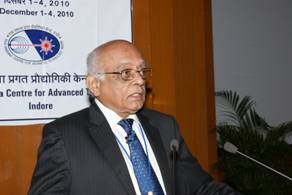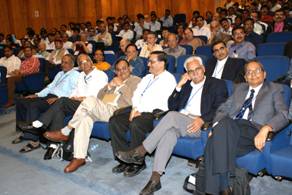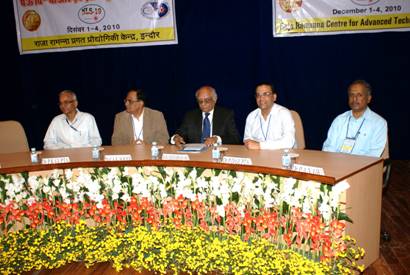| National Laser Symposium - 2010 (NLS - 19) held at RRCAT
The National Laser Symposium is an established annual event, with Raja Ramanna Centre for Advanced Technology (RRCAT) hosting the 19th NLS in this series from the 1st to the 4th December 2010. The inaugural function was held in the Central Complex Auditorium at RRCAT on the 1st December morning. This function was presided over by Dr. P.D. Gupta, Director RRCAT. The chief guest of the function was Dr. R. Chidambaram, Principal Scientific Adviser to the Govt. of India. The other persons present at the function were: Prof A. K. Sood, (Professor, I.I.Sc. Bangalore), Dr. P. K. Gupta (President, Indian Laser Association), Dr. P. A. Naik, (Convener, National Laser Symposium) and Dr. Arup Banerjee (Scientific Secretary, National Laser Symposium).
Dr. P. D. Gupta welcomed Dr. R. Chidambaram and all the participants of the symposium who came from the various parts of the country to the RRCAT. This was followed by an address by Dr. Chidambaram titled: “Laser, Photonics, Development and Society”. In his presentation, Dr. Chidambaram highlighted the various milestones achieved by some of the premier institutes in the country in the sphere of laser developments and their applications. Among the work carried out at RRCAT, Dr. Chidambaram mentioned about the work on laser driven electron acceleration and other experiments related to high energy lasers, development of high power Nd:glass laser chain, laser driven multi megabar shock generation, laser cooling and trapping of atoms, fluorescence and Raman spectroscopy for cancer diagnosis, development of fibre-coupled nitrogen laser for treatment of tuberculosis, development of opthalmic green laser for to treat diabetic retinopathy, development of high power lasers for industrial applications, and several applications of lasers developed at RRCAT that have played a significant role in India’s nuclear power programme. Dr. Chidambaram, also highlighted some of significant developments made by the defense laboratories, including Laser Science and Technology Centre, Delhi like, short range laser dazzling systems, test systems for IR guided missiles, laser warning sensors, laser range finders for MIG-29 and Navy, cannon launched missile development and aero-stabilized laser seeker. Further Dr. Chidambaram indicated some of the prominent areas of research that are being supported by the government, in the broad area of photonics and talked on the “Photonics Initiative” that has been initiated by his office to prepare a technology roadmap, thereby identifying the thrust areas and the technology gap areas vis-à-vis the scientific capabilities already existing in the country, and those which need to be created.
 
This talk was followed by the keynote address by Prof. A. K. Sood (I.I.Sc. Bangalore). In his talk titled: "Laser as a lifeline for a condensed matter physicist”, he highlighted the significant role that laser plays in the carrying out various spectroscopic techniques, including Raman spectroscopy. He specifically highlighted the role of laser based Raman spectroscopy as an irreplaceable identification too, for the various carbon based nanostructures like graphene and C-60. Graphene, which is carbon in the form of thin sheets, promises to be a very important component of high speed devices in the future and some of these aspects were also highlighted in the address by Prof. Sood. The importance of graphene can be gauged from the fact that this year’s Nobel prize in Physics has been awarded for the discovery of graphene.

Following the keynote address, was a short review of the Indian Laser Association activities by Dr. P. K. Gupta. The function concluded with a vote of thanks by Dr. P.A. Naik, the convener of the symposium.
|
















